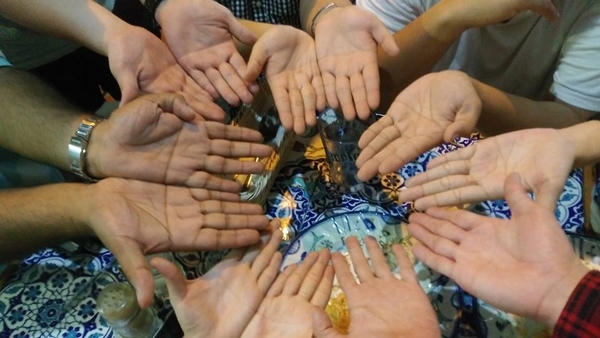
(Photo Credit Jireh Wong)
Do you have a line that crosses your palm entirely?
My Strange Hand My heart & brain line overlap It is unique so I took a snap Look at your hand & tell me this is it one or do you see a gap? I know, I know you might have two Let me know if this surprises you Huh dear palmist can I question you Who tied both lines and put glue? Kamran KOver the years I have accumulated a huge collection of images and prints of hands. I have a couple hundred ink prints and more digital images than I can keep track. We could probably speak in gigabytes! A lot of hands! Every now and then when I’m deeply involved in a particular feature or hand subject I search through my collection for samples to study and compare. As synchronicity goes, very often when I’m researching something several people show up at the events where I’m reading hands or reach out to me through my web site or Facebook pages with exactly what I’m looking for in the palms of their hands. When this happens I also have additional opportunity to ask questions and get feedback. I have several hundred examples of the various transversal creases.
From this form of study I have been able to learn more about the features of hands and go deeper into understanding the whats and whys about how the patterns got there in the first place and how they are played out in individual personality and behavior. This is how we respond to our experiences and to actual and perceived projections from others and ourselves. Our hands give us a lens into these wordless, instinctive and intuitive aspects of ourselves. We touch our world with our hands, a special connection more emotional in nature than we think. Hand Analysis is a way to examine and decode this wordless language.
“The key to an understanding of the nature of the conscious life of the soul lies in the sphere of the unconscious”
~ Carl Gustav Carus (cir 1850s)I have often shared quotes like this that describe how our body is a reflection of our entire inner essence. Our mannerisms, facial expressions, walk, talk and so much more all come together to give us our personalities and idiosyncrasies that our friends and family recognize in each other. The reason that hands can be read in such a way to accurately describe how a person expresses themselves, their behavior, and general personality is because the biological features all store and repeat these same behaviors and expressions in their own language. As within, so without.
In the worlds of palmistry, hand analysis and chirology, the interest in hands ranges from belief based insights to carefully organized schools learning and studying to advance this field into a real science. There are those who work diligently to gather data with trial and error until a nearly fail proof system is developed that is grounded in repeatable methods and results. The latter exists more in the fields of biology, medicine and forensics. The study of hands in sports medicine has taken the field to new levels of awareness where not just what appears when there’s a syndrome is important, but how the hand functions and what all that entails.

The creases develop on our palms early on in the womb setting up neural connections and preparing our hands for future human related powerful and precision hand skills and strengths. There are more connections from the hands to the brain than from any other part of the body. It is thought that as we use our hands, more connections are made.
Early research looked to see if the creases developed before or after reflexive or conscious hand movement. Only a few decades or so ago it was thought that it couldn’t be from flexing as the nervous system wasn’t developed enough in the hands for movement. As our technology advanced, the instruments were able to detect tiny nerve fibers reaching deep into the hand tissue and it became obvious that flexing was mostly involved after all. A few creases, it is thought, develop outside of flexion in anticipation for the function of underlying structure.
For those passionate about hands like myself, it is enlightening to get more and more affirmations about how our hands are such amazing instruments capable of detecting, sending and receiving all kinds of energy. And, most important of all is the confirmation that the essence of our life experiences, good and bad, is stored in the cells of our body to help us navigate life for survival and thriving. They also contain a lot of baggage that drags us down as we add more and more experiences to our lives. From the creases, and other features, we can tell where we are coming from genetically, epi-genetically, as well as how we have stored protective mechanisms, preferences and pleasures, many of which are at a subconscious, wordless and instinctive level. We think that inner voice is always right when we feel warned, but sometimes the associations are false alarms. We store our experiences in the form of what we have taken in with our senses. This is how things, like scents or color combinations, can trigger memories from the past or feelings surface that seemingly make no ‘sense’ in the current moment.
It is an imperative belief of the natural scientist that each and every modification of a subjective state in the sphere of the senses corresponds to an objective state.”
~ Jan Evangelista Purkinje (1823)The various ways our major and minor creases form in our hands are reflections of early prenatal development, the environment, use of our hands after birth, and how we are hinged together to bend and move that have subtle differences that are unique to each individual.
The Distal Transverse Crease, or Heart Line (lll), is the top horizontal crease in the palm under the fingers. A minor crease, called the Girdle of Venus that curves, or angles, from between the index and middle fingers to over and up between the ring and little fingers, is located higher up. The heart line runs along just under the tops of the metacarpophalangeal joints of the little, ring and middle fingers. Prenatally it first appears as a short crease between the index and middle fingers at around 10 to 11 weeks after conception. Earliest hand to face movement of the fetus is at about 12 to 13 weeks. Sometimes this short crease becomes the Girdle of Venus during formation and the heart line goes elsewhere. After birth the Heart Line is viewed in most fields as starting on the little finger or ulnar side of the palm and usually seen as gently curving upward toward the space in between the index and middle fingers.
The index finger’s metacarpophalangeal joint marks the location of the Proximal Transverse Crease or the Head Line’s (ll) beginning on the thumb or radial side of the palm. This crease is connected to the opening, closing and pointing of the index finger and runs across the palm at a slightly downward slope, ending usually in the area down below the ring finger. Starting its journey at about 13 to 14 weeks after conception, it is not as restricted in its boundaries, as it reaches across the hand, as are the heart and life lines with their boundaries.
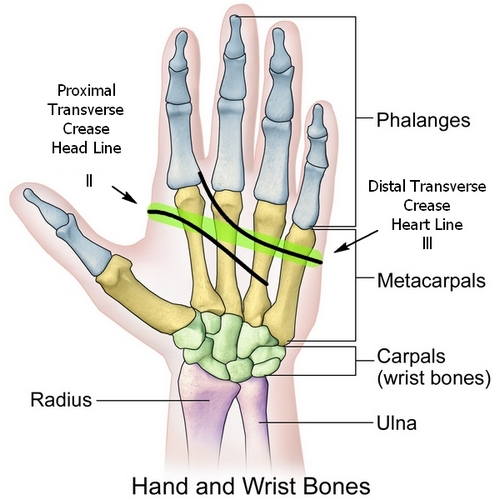 adapted from image via wiki – credit: Blausen.com staff
adapted from image via wiki – credit: Blausen.com staff
Typically these two creases do not move straight across the palm and merge with each other. Generally there is a space between the two creases that is often connected by one or two angled branches towards the center of the palm in this space as well as other finer miscellaneous branches reaching out from one crease to the other. This is what is considered normal or the most commonly found configurations of the heart and head lines. Even within this common category there is room for numerous variations.
The main essence psychologically would be the separation of the heart and mind. The connections between the two, or lack thereof, allow people to be able to tell if the choices they are making are based on emotions or if they are excluding feelings and acting based on mentality, or the conscious awareness of a balance between the two. When these creases join, this separation of heart and mind is blurred or altered. This can make it hard to make emotional decisions without giving it lots of thought and the reverse in making logical decisions without feeling personally involved. It can be a powerful tool in the right hands. There is also a division formed by these complete transversal creases between the top of the hand and what it represents and the bottom part of the hand and its influence.
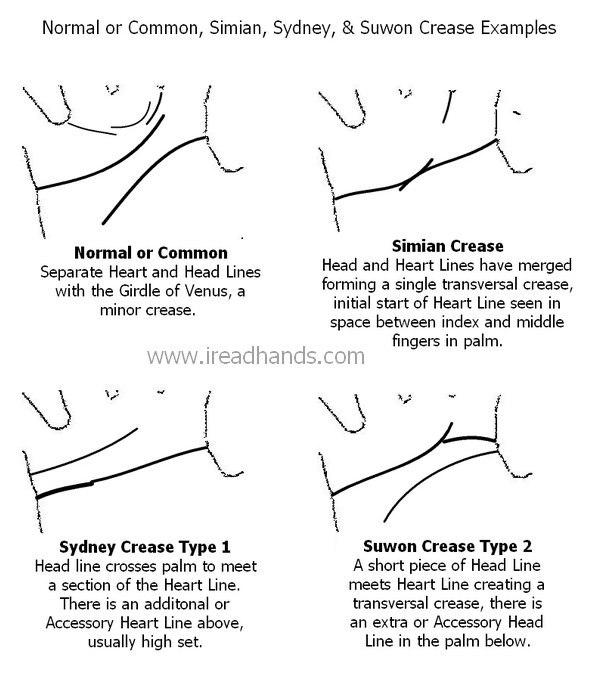
So what does this all have to do with a Suwon, Sydney and Simian Crease and how they compare to what is considered Normal or Common? I had hoped to briefly (seriously, this topic could be a whole book of information) share information that shows how the creases form and their primary functions. The idea that they are imprints, or a configuration that is genetically predetermined and represent a known or unknown syndrome is far from the whole story. From my studies, I’ve come to an understanding that the patterns, showing up frequently in situations where a child is born with a syndrome, or a birth defect, relate to a disturbance in sequence and timing of growth patterns than to a design formed by genetic code. Instead the feature is doing its best with what it’s got to work with, to complete itself and function as needed. Disturbances or differences, in how the hand forms, can reflect variations in what is known as the speed, order and timing of the various parts forming, growing, and coming together during development. These factors can also be determined both by genetics and environment.
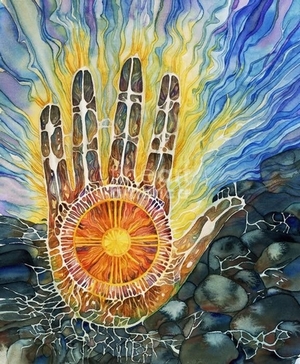
Helen Nelson Reed – Artist
The length of the palm and the surface space that has to bunch up in making a fist play a role in the location, depth, length, and number of major transverse creases. Too long of a palm results in extra horizontal creases, such as the heart line and head line. Extra heart and head lines have been identified and labeled as Accessory in the most recent research on Palmar Creases. When the palms are short, the heart and head line, which sit on the same plane in the palm across from each other, radially and ulnarly, can more easily run together in one crease across the palm.
These multiple long crossing creases form in a variety of ways, but there are common patterns of forming that can be divided into types: Suwon, Sydney and Simian. These three can be subdivided into more categories to help them become easily recognizable by their various constructions and parts. The Simian has been known and studied the longest. It was named after primates as those with the longer palms have multiple transversal creases. The Sydney was named for the city where the researchers identified it in 1968 in Australia. In 2010, Korean researchers at Ajou University School of Medicine in Suwon, Korea, defined the sister pattern to the Sydney, the Suwon.
Interestingly, once you’ve studied the chart below, you will see a fascinating effect where the Suwon is actually an up-side-down mirror image of the Sydney. There’s an explanation for this as well. Until recently, most varieties of these three configurations were defaulted to a Simian based on a lack of understanding of the functions of the major and minor creases, along with inconsistent classification methods and standards. In my opinion, the Simian is a generality for all types of creases that cross the palm. Under this umbrella term are the variations that range from completely fused Distal and Proximal Transverse Creases (heart and head lines), to the Sydney, the Suwon and their variations, plus other transversal configurations that can appear in the palms of the human hand. My follow up report to this one will describe how to decipher and interpret these combinations in detail with illustrations, case studies and examples.
(Click on chart for larger image. Printable at 8.5 X ll” available for purchase, see details below)
The system used in this chart utilizes and expands the coding system developed by the Korean scientists in their report “Improved Analysis of Palm Creases” At link, click on “free text” to read entire article.
The creases were called the joints of the skin by anatomist Frederic Wood Jones. These creases are attached to layers of skin and deeper mechanisms in the underlying structure of the hand. The heart line is actually aligned with and part of a system working together that connects to pulleys which connect to the digits. Just know when you extend your hand and open your fingers, you tug at your heart strings, too. If you think about the different feelings between shaping your hand into a fist and an open hand, it makes sense. Earlier I was looking through my old notes kept in a scrapbook and came across a question I had scribbled down to come back to later. I had written “Why do open and closed hands feel so different?” At the time I was reading David J. Linden’s book, “Touch”. Now I learn that our fingers are pulled shut by our heart line! Wow! Our head line and index finger are involved too, but that will be described in the part below about the Suwon Crease.
“We touch the world with our hands, a special connection more emotional in nature than we think. Hand Analysis is a way to examine and decode this wordless language.” ~ Patti Lightflower
After the identification of the Sydney Crease, more and more cases were gathered and documented, and rules were given as to what defined a Sydney. Although the line drawings in the text books and literature showed a variety of types, the issue arose about where the end of this long head line should be. What sets the Sydney apart from the Simian is that while it is a complete transversal crease, which is a crease that completely crosses the palm from side to side, it also has an obvious additional heart line above. The Simian has no additional heart line or head line. Yet, it is very rare to find a palm that doesn’t have some form of remnants, or what I call tails, continuing beyond, above and/or below the merging of the two major transverse (horizontal) creases. At the time the Sydney was first identified it was seen as a long, long head line. Because of this there were rules as to how long it needed to be. Some insisted it had to go off the side of the hand in a deep fashion, others were okay with it fading out and ending down the palm, midway under the little finger or beyond. This would be a very short distance to the edge of the palm, but not entirely. These two different views are actually related to two kinds of Sydneys. They were sketched in examples in early lists of variants, but it seems they haven’t been defined as two different types of Sydneys, made of different components with different expressions in personality and behavior, until now, in my presentation!
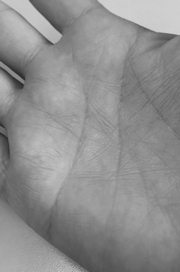 Sydney Type 2
Sydney Type 2
The long head line Sydney tends to have a normally placed heart line above. Its main distinction is the very long and slightly downward sloping head line. In some cases, the Sydney Crease, like the Simian, is found on newborns with syndromes or birth defects, as well as many infants that apparently have no health issues. All of the transversal creases are associated with not so ordinary behavior. But then I think this is like left handed people living in a right handed world, they have to constantly be aware that they process or utilize things differently than the world around them. So others might see them as not conforming or difficult. Particularly as children. I have this type of Sydney in my left hand. I have lots of childhood stories. Yet it’s very good for concentration, research and thinking and thinking and thinking.
The second type of Sydney Crease has an appearance that is closer to the typical Simian. There is the deep crease cutting across the hand, which is caused by the joining of the heart line and the head line, yet there is another heart line above. The natural location for the heart line to form is under the metacarpophalangeal joints. On the ulnar or little finger side of the palm, the heart line is formed by the flexing at the tips of the metacarpophalangeal joints of the little, ring and middle fingers. You can feel this by folding your fingers held together into the palm. Notice how the heart and head lines become on the same plane. In some palms that do not have these transversal creases, they appear to do so when the hand is folded this way. This illustrates they are on the same plane in the hand. Hand splints for injured hands have to end below this singular fold for the person to be able to use their fingers while other parts of the hand are restrained.
Essentially, the difference between the two Sydney types is that one is basically an unusually long head line and all else is generally normal, and the other is the conjoined head and heart line, along the plane just described, plus the appearance of another heart line above. Since the location for the normal heart line is already taken by the piece that joins the head line, this Sydney type heart line is forced to form higher up near the fingers. Here it can appear in several common formations which typically involve the minor creases, known as the Relationship Lines and the Girdle of Venus, to be hi-jacked for its own design. I have illustrated these in my chart below. When creases find themselves in territories that are not their own, they take on the energy of the territory they have found themselves, they also may not function the same as either the crease it confiscated, or itself, if some mix of the two. I’ll explain this in detail in a more focused and detailed report in the near future and linked to this blog post describing these variations and how they play out in day to day life.
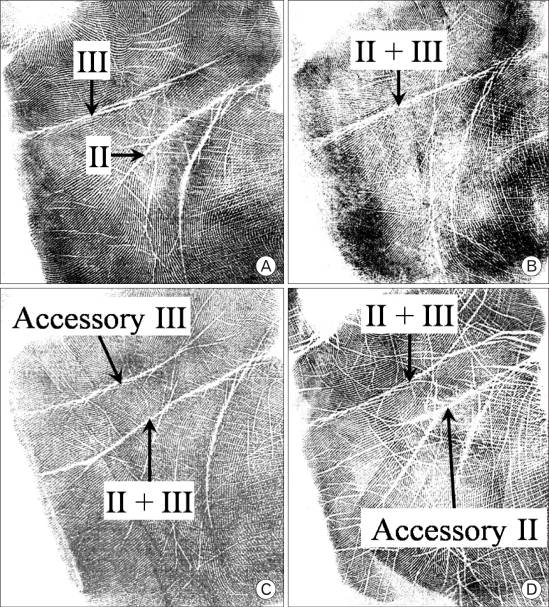 A) Normal or Common Palm Creases: ll and lll do not meet (Head and Heart Lines). B) Simian: ll and lll meet to cross palm. C) Sydney: ll and lll meet, accompanied by an additional Accessory lll (additional heart line). D) Suwon: ll and lll meet, accompanied by an additional Accessory ll (additional head line). Adapted from the Korean 2010 report.
A) Normal or Common Palm Creases: ll and lll do not meet (Head and Heart Lines). B) Simian: ll and lll meet to cross palm. C) Sydney: ll and lll meet, accompanied by an additional Accessory lll (additional heart line). D) Suwon: ll and lll meet, accompanied by an additional Accessory ll (additional head line). Adapted from the Korean 2010 report.
Just as there are two Sydney types there are also two Suwon types. The report linked to above, entitled “Improved Analysis of Palm Creases”, appeared on the scene around this time in 2010. During their study of the thousands of hand prints they had collected and sorted, they discovered that a few of those with the transversal creases had something not defined beyond a few brief mentions in literature from the 70’s. It had been basically overlooked as a specific type of configuration that needed its own category.
Following the rules they had outlined on how to define the minor creases from the major creases and how to discern their direction, (much like Julius Spier’s methods recorded in “The Hands of Children” 1944) they discovered that this pattern fit into a category where there’s a complete transversal crease formed by the meeting of two major creases, yet there is another crease, or creases, that function in the form of another heart line above or head line below. These additional heart and head lines are seen and labeled as Accessory lll and ll. There are guidelines as to how to define minor creases from major creases and it’s possible to tell when minor creases have become major creases to supplement for a missing component of a major crease.
The first of the two types of Suwon Creases involves a heart line that crosses the entire palm and fades out under the index finger on the pad below. If this ending doesn’t fade to a thinner point or finer branches but reaches the edge deeply, it may be the second type. This former type is basically a very long heart line that either doesn’t aim up towards the fingers but instead crosses the palm, or has a branch or branches that aim upward along with clearly a branch that fades out while aiming toward the radial edge of the palm. A normal looking head line is below.
The second type of Suwon involves a section of head line starting from the radial side of the hand in a location that a head line can normally be found starting. This piece reaches out and makes contact with the heart line. Sometimes this is the pointed tip making a slight contact and other times they merge strongly into one transversal crease. There is an additional head line below. Basically it is two head lines and one heart line, like the Sydney is two heart lines and one head one. If you ignore the presence of the life line, you will notice sometimes that this second head line (Called Accessory ll) has the appearance of being broken and cascading down the palm. The Sydney head line can do the same type of cascading but it mostly happens from the middle toward the ends and the Suwon is cascading from the start on the thumb side.
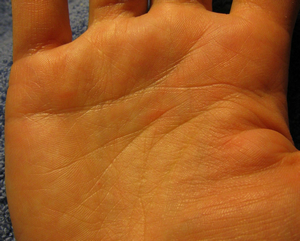
Suwon Type 2
The Korean report mentioned above suggests that these creases come together for powerful hand grip. Powerful grip is a form of shaping the hand around a tool or object and being able to use a lot of force with steadiness and control. Our hands are constructed following a common general plan for the human hand, but the variations allow for all kinds of thicknesses, flexibility, stiffness, weaknesses and strengths in different areas of the hand. As I’ve written above all of these are reflected also in our personality, behavior, and responses to life experiences. The creases that form, to adapt our grasping for getting a good grip on life, are a reflection of who we are.
I’ll bet what most of you are saying after reading through this, or scrolling to the bottom to see in advance “But, what does it mean???” Coming soon!
“The sum total of our inner instructions is how we present ourselves through our bodies in our world.”
~ Jim Morningstar
I hope you have enjoyed my blog post!
If you think you have a Suwon or unusual creases that are difficult to figure out what they are, you are welcome to send a clear photo to me and I’ll take a look and tell you what I think.
in joy,
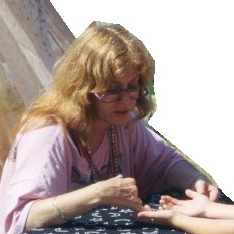
Patti Lightflower
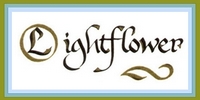
Recommended Reading and References:
“Touch: The Science of Hand, Heart, and Mind” David J. Linden, Prof. of Neuroscience, The Johns Hopkins University School of Medicine 2015
“Improved Analysis of Palm Creases” Jin Seo Park etal. Dept. of Anatomy, Ajou University School of Medicine, Suwon, Korea 2010
“The Untethered Soul” Michael A. Singer 2007
“Palmar, Plantar, and Digital Flexion Creases: Morphologic and Clinical Considerations” Blanka A. Schaumann, PhD, and Sumiko Kimura, PhD
“Embryologic Development of Flexion Creases” Sumiko Kimura, PhD (both of these articles are published in “Dermatoglyphics, Science in Transition” 1991)
“Developmental Aspects of Human Palmar, Plantar and Digital Flexion Creases” Sumiko Kimura, Blanka A. Schaumann, Chris C. Plato, Tadashi Kitagawa (published in “Trends in Dermatoglyphic Research” 1990)
“Dermatoglyphics in Medical Disorders” Blanka Schaumann and Milton Alter 1976
“Maternal, Fetal, & Neonatal Physiology” 3rd Edition Susan T. Blackburn 2007
“Palmar and Plantar Dermatoglyphics in Primates” Charles Midlo & Harold Cummins 1942
“The Hands of Children” Julius Spiers 1944
“The Biology of Belief” Bruce Lipton 2008
“Protective buttressing of the human fist and the evolution of hominin hands” 2013, Morgan & Carrier, The University of Utah School of Medicine

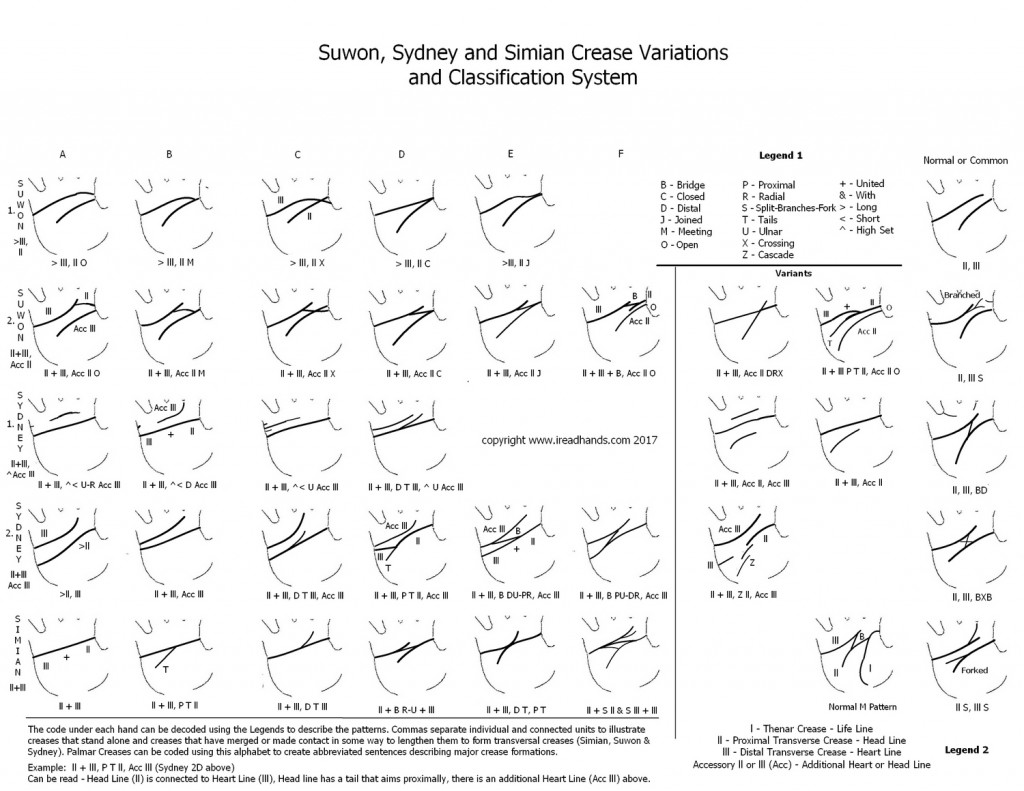

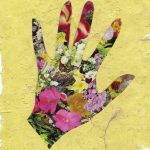
A brilliant analysis!
Thank you Sonia!
Beautiful framework of psychology through the tapestry of creases formed by the functional postures of our hands. Looking forward to next blog on this topic!
Thank you Boaz! I appreciate this feedback!